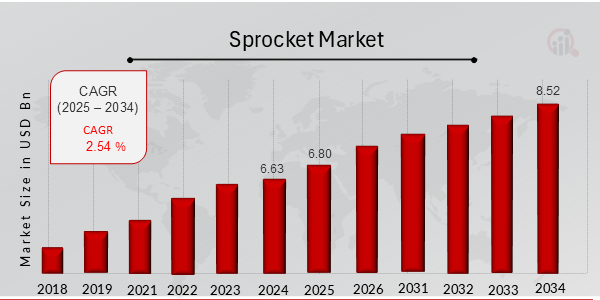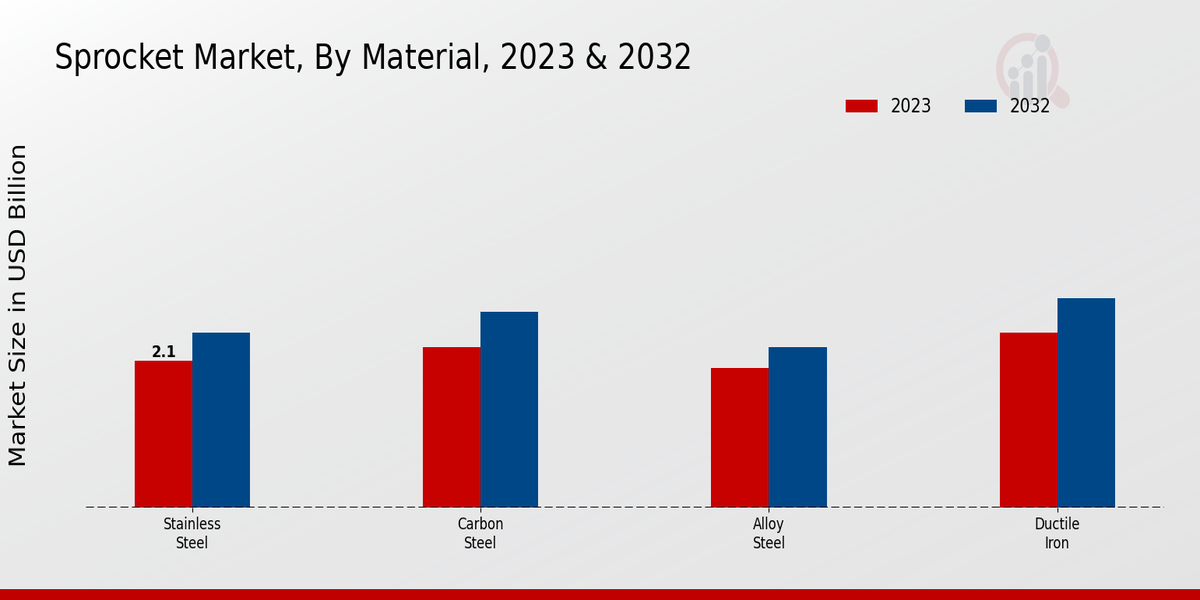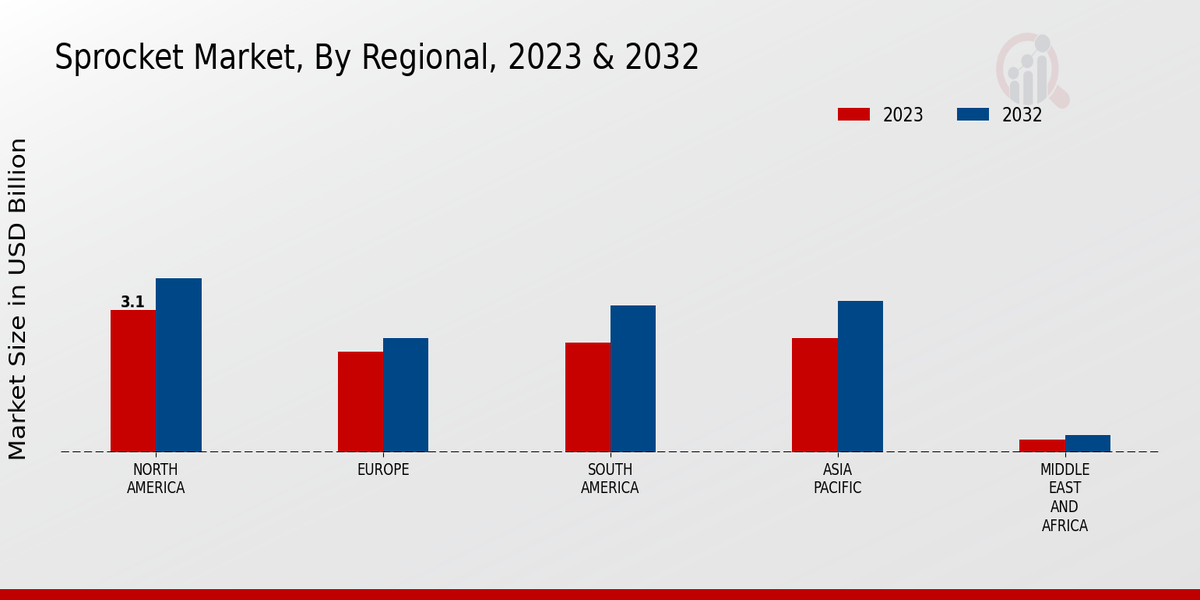Global Sprocket Market Overview:
As per MRFR analysis, the Sprocket Market Size was estimated at 6.63 (USD Billion) in 2024. The Sprocket Market Industry is expected to grow from 6.80 (USD Billion) in 2025 to 8.52 (USD Billion) till 2034, at a CAGR (growth rate) is expected to be around 2.54% during the forecast period (2025 - 2034).
Key Sprocket Market Trends Highlighted
Key market drivers for the sprocket market include increasing industrial automation, rising demand for agricultural machinery, and the growing construction sector. Advances in technology have led to the development of more efficient and durable sprockets, driving market growth. Unexploited opportunities in the sprocket market exist in the renewable energy sector, where sprockets are used in wind turbines and solar tracking systems. Furthermore, increasing investment in infrastructure projects is expected to create new opportunities for sprocket manufacturers.
Recent trends in the sprocket market include the adoption of lightweight materials such as carbon fiber and titanium, improving performance and reducing weight. Additionally, the rising popularity of electric vehicles is driving demand for sprockets in electric motors and drive systems. Key players in the sprocket market are continuously innovating to meet changing customer needs. They are investing in research and development to enhance product quality, durability, and efficiency. Partnerships and collaborations between manufacturers and end-users are becoming increasingly common, leading to customized solutions.

Source: Primary Research, Secondary Research, MRFR Database and Analyst Review
Sprocket Market Drivers
Technological Advancements in Manufacturing Processes
The Sprocket Market Industry is experiencing significant growth due to technological advancements in manufacturing processes. These advancements have led to the development of more efficient and cost-effective production methods, which have, in turn, reduced the prices of sprockets. This has made sprockets more accessible to a wider range of customers, which is driving up demand.
In addition, technological advancements have also led to the development of new and innovative sprocket designs, which offer improved performance and durability. These factors are all contributing to the growth of the Sprocket Market Industry. One of the most significant technological advancements in the manufacturing of sprockets is the use of computer-aided design (CAD) and computer-aided manufacturing (CAM) software. This software allows manufacturers to create complex sprocket designs and to simulate their performance before they are actually produced. This helps to ensure that sprockets are designed to meet specific requirements and that they will perform as expected.
In addition, CAD/CAM software can be used to automate the manufacturing process, which can reduce costs and improve efficiency. Another important technological advancement in the manufacturing of sprockets is the use of new materials. These materials are often stronger and more durable than traditional materials, and they can also be more resistant to wear and corrosion. This makes sprockets made from these new materials more durable and longer lasting, which can reduce replacement costs and downtime.
The combination of technological advancements in manufacturing processes and the use of new materials is leading to the growth of the Sprocket Market Industry. These advancements are making sprockets more affordable, more efficient, and more durable, which is driving up demand. As these advancements continue, the Sprocket Market Industry is expected to continue to grow in the years to come.
Rising Demand from Industrial Sectors
Sprockets are also in high demand from industrial sectors. Sprockets are used in a wide variety of industrial applications within power transmission, material handling, and construction. As industrial sectors continue to grow, so too will the demand for sprockets. Furthermore, the growing trend of automation in industrial processes is also increasing demand for sprockets. Sprockets are used in a wide range of automated systems. One of the key industrial sectors that is driving demand for sprockets is the automotive industry.
Sprockets find use in a wide range of automotive applications, including engine timing, transmission, and power steering. As the automotive industry continues to grow, so too will the demand for sprockets. Moreover, the increasing interest in electric vehicles is also increasing demand for sprockets. Electric vehicles require more sprockets than traditional gasoline-powered vehicles because they replace metal gears and mechanical linkages in traditional internal combustion engines with sprockets and chains to connect the vehicles’ electric motors to the wheels.
Another key industrial sector that is driving demand for sprockets is the construction industry. Sprockets are used in a wide range of construction applications, including cranes, hoists, and screw conveyors. As the construction industry continues to grow, so too will the demand for sprockets. Moreover, the rising interest in prefabricated construction methods is also driving demand for sprockets. Prefabricated construction requires more sprockets than traditional construction methods.
Increasing Adoption of Renewable Energy Technologies
The Sprocket Market Industry is benefiting from the demand created by the rising adoption of renewable energy technologies. Sprockets are used in a range of renewable energy applications, including wind turbines, solar panels and hydroelectric generators. As the world experiences a continued trend of a shift toward renewable energy sources, then the demand for sprockets will undoubtedly grow. In addition, as more microgrids and distributed generation are being used, their demand for sprockets will be higher as they require more sprockets than traditional centralized generation uses.
The first renewable energy technology that uses sprockets and whose increasing use is driving the demand for the products is wind energy. Sprockets are used in wind turbines to convert the kinetic energy of the wind to electrical energy. As the wind energy industry is growing, then there will be an increased demand for the sprockets. In addition, the growing use of offshore wind farms is also driving the demand for sprockets as offshore wind farms require more sprockets than onshore wind farms.
The second renewable energy technology that uses sprockets and whose increasing use is driving the demand for sprockets is solar energy. Sprockets are used in solar panels to convert the sunlight to electrical energy. As the solar energy industry is growing, then there will be a higher demand for the sprockets. In addition, the growing use of solar microgrids and distributed generation is also driving the demand for sprockets, as these systems require more sprockets than traditional centralized generation systems use.
Sprocket Market Segment Insights:
Sprocket Market Material Insights
The Sprocket Market is classified on the basis of material. The key Segments of the Sprocket Market on the basis of material are Stainless Steel, Carbon Steel, Alloy Steel, and Ductile Iron. By material type, the Stainless Steel material segment is anticipated to hold the maximum market share in the year 2023 and is projected to dominate the market throughout the forecast period. The growth of the stainless steel material segment is primarily driven by the increasing demand for stainless steel sprockets across end-use industries such as food processing, pharmaceutical, and chemical processing, owing to the high corrosion resistance, strength, and durability in harsh environments.
The carbon steel material segment is anticipated to exhibit a slow growth rate during the forecast period. The carbon steel material segment is expected to dominate the material segment in the overall Sprocket Market. The carbon steel material segment is highly used in automotive, construction, and industrial machinery equipment owing to the low cost and good strength to weight ratio. However, the growth of the carbon steel segment is expected to be limited by emerging alternatives such as aluminum and composite materials. The Alloy Steel material segment is anticipated to grow with a moderate CAGR during the forecast period.
The growth of the alloy steel material segment is primarily characterized by the high strength, wear resistance, and high toughness of the material due to which it is highly preferred in heavy machinery, mining, and construction equipment. The Ductile Iron material segment is anticipated to exhibit a stable growth rate during the forecast period. The growth of the Ductile Iron material segment is mainly attributed to the increasing demand for high strength and durability in agricultural machinery, mining equipment, and heavy industrial machinery applications.
On the whole, the Sprocket Market is expected to portray a steady growth rate over the forecast period. The growing demand across end-use industries and the increasing need for performance-based sprockets is expected to drive the market growth. The Sprocket Market is expected to be restricted by increasing demand for automated sprocket products, the growth of the lightweight material segment, and technological advancements.

Source: Primary Research, Secondary Research, MRFR Database and Analyst Review
Sprocket Market Size Insights
The Sprocket Market is divided by size into small below 10 inches, medium 10-20 inches, and large above 20 inches. It is expected that the small-sized segment will constitute the biggest share of the market by 2023, being valued at 2.1 billion USD. This might be driven by the growing number of applications of small sprockets in automotive machinery and industrial applications among others.
The medium-size segment is anticipated to have a 2.8% CAGR by 2032, being valued at 2.5 billion USD by then. The large-size segment is expected to have a 2.2% CAGR by 2023-2032, being valued at 3.3 billion USD by 2032.
Sprocket Market Teeth Type Insights
They are characterized by their straight teeth, which mesh with the teeth of a chain or belt. Helical Teeth Sprockets have teeth that are cut at an angle to the sprocket's axis. This design provides for smoother operation and reduced noise than straight teeth sprockets. Helical teeth sprockets are often used in high-speed applications. Herringbone Teeth Sprockets have teeth that are cut in a V-shape. This design provides for even smoother operation and reduced noise than helical teeth sprockets. Herringbone teeth sprockets are often used in very high-speed applications.
Bevel Teeth Sprockets have teeth that are cut at an angle to the sprocket's axis, but the teeth are not parallel to each other. This design allows for the transmission of power between shafts that are not parallel. Bevel teeth sprockets are often used in right-angle drives. The choice of sprocket type depends on the specific application. Factors to consider include the speed of the application, the load, and the noise level.
Sprocket Market End-use Industry Insights
The Sprocket Market is segmented by end-use industry into automotive, industrial machinery, construction, and aerospace. The automotive industry is the largest end-use industry for sprockets, accounting for over 40% of the global market revenue in 2023. This is due to the large number of sprockets used in automotive applications, such as in engines, transmissions, and differentials. The industrial machinery industry is the second largest end-use industry for sprockets, accounting for over 30% of the global market revenue in 2023. This is due to the use of sprockets in a wide range of industrial machinery, such as in conveyors, cranes, and elevators.
The construction industry is the third largest end-use industry for sprockets, accounting for over 20% of the global market revenue in 2023. This is due to the use of sprockets in a variety of construction equipment, such as excavators, bulldozers, and cranes. The aerospace industry is the fourth largest end-use industry for sprockets, accounting for over 10% of the global market revenue in 2023. This is due to the use of sprockets in a variety of aerospace applications, such as in aircraft engines, landing gear, and flight controls.
Sprocket Market Regional Insights
The Sprocket Market segmentation by region includes North America, Europe, APAC, South America, and MEA. North America is expected to dominate the market with a revenue of 3.1 Billion USD in 2024, owing to the presence of major automotive and industrial machinery manufacturers.
Europe is projected to follow with a market value of 2.2 Billion USD in 2024 due to its strong automotive industry. APAC is anticipated to witness significant growth at a CAGR of 3.5% during the forecast period, driven by the rising demand for sprockets in emerging economies like China and India.South America and MEA are expected to contribute a smaller share to the global market due to their less developed automotive and industrial sectors.

Source: Primary Research, Secondary Research, MRFR Database and Analyst Review
Sprocket Market Key Players And Competitive Insights:
Major players in the Sprocket Market are constantly developing and innovating new products to meet the changing demands of the market. Leading Sprocket Market players are investing heavily in research and development to maintain their competitive edge. Sprocket Market development is driven by the increasing demand for sprockets in various industries such as automotive, construction, and manufacturing. The Sprocket Market Competitive Landscape is highly fragmented, with a large number of players. However, a few major players dominate the market, accounting for a significant share of the revenue.
A leading player in the Sprocket Market is Renold, a British company that has been manufacturing sprockets for over 100 years. Renold offers a wide range of sprockets, including chain sprockets, timing sprockets, and gear sprockets. The company has a strong global presence with manufacturing facilities in the United Kingdom, the United States, Canada, and India. Renold's customers include major automotive manufacturers, construction companies, and industrial machinery manufacturers.
A competitor to Renold in the Sprocket Market is Tsubaki, a Japanese company that has been manufacturing sprockets for over 80 years. Tsubaki offers a similar range of sprockets to Renold, including chain sprockets, timing sprockets, and gear sprockets. The company has a strong presence in Asia, Europe, and the Americas. Tsubaki's customers include major automotive manufacturers, construction companies, and industrial machinery manufacturers.
Key Companies in the Sprocket Market Include:
- Continental AG
- GKN Automotive
- BorgWarner Inc.
- Aisin Seiki Co., Ltd.
- Mitsubishi Heavy Industries Ltd.
- Schaeffler AG
- Valeo SA
- Dana Incorporated
- ZF Friedrichshafen AG
- Tsubakimoto Chain Company
- NTN Corporation
- Sumitomo Electric Industries, Ltd.
- JTEKT Corporation
- The Timken Company
Sprocket Market Industry Developments
The Sprocket Market is anticipated to reach USD 8.52 billion by 2034, exhibiting a CAGR of 2.54% from 2025 to 2034. Growing demand for sprockets from the automotive and manufacturing industries, coupled with rising construction activities, is expected to drive market growth.
The increasing adoption of electric vehicles and the expansion of the automotive aftermarket are contributing to the demand for sprockets. Additionally, advancements in manufacturing technologies and the introduction of innovative products are expected to create new opportunities for market growth.
Sprocket Market Segmentation Insights
Sprocket Market Material Outlook
- Stainless Steel
- Carbon Steel
- Alloy Steel
- Ductile Iron
Sprocket Market Size Outlook
- Small (Below 10 Inch)
- Medium (10-20 Inch)
- Large (Above 20 Inch)
Sprocket Market Teeth Type Outlook
- Straight Teeth
- Helical Teeth
- Herringbone Teeth
- Bevel Teeth
Sprocket Market End-use Industry Outlook
- Automotive
- Industrial Machinery
- Construction
- Aerospace
Sprocket Market Regional Outlook
- North America
- Europe
- South America
- Asia Pacific
- Middle East and Africa
| Report Attribute/Metric |
Details |
|
Market Size 2024
|
6.63 (USD Billion)
|
|
Market Size 2025
|
6.80 (USD Billion)
|
|
Market Size 2034
|
8.52 (USD Billion)
|
|
Compound Annual Growth Rate (CAGR)
|
2.54% (2025 - 2034)
|
|
Report Coverage
|
Revenue Forecast, Competitive Landscape, Growth Factors, and Trends
|
|
Base Year
|
2024
|
|
Market Forecast Period
|
2025 - 2034
|
|
Historical Data
|
2019 - 2023
|
| Market Forecast Units |
USD Billion |
| Key Companies Profiled |
Continental AG, GKN Automotive, BorgWarner Inc., Aisin Seiki Co., Ltd., Mitsubishi Heavy Industries Ltd., Schaeffler AG, Valeo SA, Dana Incorporated, ZF Friedrichshafen AG, Tsubakimoto Chain Company, NTN Corporation, Sumitomo Electric Industries, Ltd., JTEKT Corporation, The Timken Company |
| Segments Covered |
Material, Size, Teeth Type, End-use Industry, Regional |
| Key Market Opportunities |
Adoption of Electric Vehicles Automation in Manufacturing Growing Industrial Automation Penetration in Aerospace and Defense Expansion of Renewable Energy |
| Key Market Dynamics |
Rising demand technological advancements increasing automation supply chain disruptions competitive landscape |
| Countries Covered |
North America, Europe, APAC, South America, MEA |
Frequently Asked Questions (FAQ) :
The Sprocket Market is expected to reach approximately 6.80 Billion USD in 2025.
The Sprocket Market is projected to grow at a CAGR of 2.54% from 2025 to 2034.
The Asia Pacific region is expected to hold the largest market share in the Sprocket Market in 2023.
Sprockets are widely used in power transmission systems, automotive, construction, and agricultural machinery.
Some of the key players in the Sprocket Market include Renold, Tsubakimoto Chain, Dongguan Guanfeng Gear, and Martin Sprocket & Gear.
The increasing demand for sprockets in various industries, such as automotive and construction, is driving the growth of the Sprocket Market.
The Sprocket Market is facing challenges such as intense competition and fluctuating raw material prices.
The growing adoption of sprockets in emerging economies and the development of new applications are creating opportunities for growth in the Sprocket Market.
The increasing demand for lightweight and durable sprockets is a key trend shaping the Sprocket Market.
The Sprocket Market is expected to reach approximately 7.9 Billion USD by 2032.

















